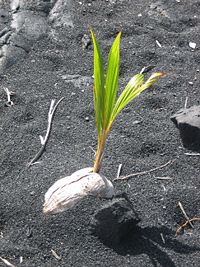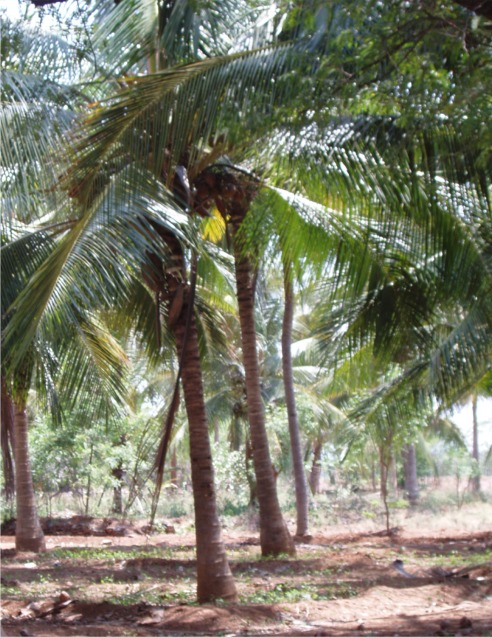Coconut



Coconut Germinating Coconut Coconut Palm
Coconut is not a spice but is commonly used in many countries in cooking and in general use, so we give you a description of it here. The term coconut refers to the fruit of the coconut palm. The coconut palm is grown throughout the tropical world, for decoration as well as for its many culinary and non-culinary uses. Virtually every part of the coconut palm has some human uses.
A coconut is a simple dry nut known as a fibrous drupe. The outer husk is composed of fibres called coir and there is an inner stone, or endocarp. The endocarp is the hardest part. This hard endocarp, the outside of the coconut has three germination pores that are clearly visible on the outside surface once the husk is removed. It is through one of these that the radicle emerges when the embryo germinates. Adhering to the inside wall of the endocarp is endosperm or the coconut "meat", the white and fleshy edible part of the seed.
Although coconut meat contains less fat than other dry nuts such as peanuts and almonds, it is noted for its high amount of saturated fat. Approximately 90% of the fat found in coconut meat is saturated, a proportion exceeding that of foods such as lard or butter. Coconut meat also contains less sugar and more protein than popular fruits such as bananas, apples and oranges, and it is relatively high in minerals such as iron, phosphorus and zinc.
The endosperm surrounds a hollow interior cavity which is filled with often a liquid referred to as coconut water which contains sugar, fibre, proteins, antioxidants, vitamins and minerals. Coconut water from the unripe coconut, however, can be drunk fresh. Young coconuts used for coconut water are called tender coconuts. The water of a tender coconut is liquid endosperm. It is sweet (mild) with aerated feel when cut fresh. When the coconut is still green, the endosperm inside is thin and tender, often eaten as a snack. But the main reason to pick the nut at this stage is to drink its water. This coconut water will replenish body fluids in cases of dehydration following diarrhoea and is often used for this purpose in those countries where fresh young coconut is available. Coconut water provides an isotonic electrolyte balance, and is a highly nutritious food source. It is used as a refreshing drink throughout the humid tropics and is also used in isotonic sports drinks. Mature fruits have significantly less liquid than young immature coconuts; barring spoilage, coconut water is sterile until opened.
Coconut water should not be confused with Coconut milk which is made by grating the endosperm and mixing it with (warm) water and squeezing out the liquid. The resulting thick, white liquid which is the coconut milk is used in much Asian cooking, for example, in curries.
Culinary uses:
Nearly all parts of the coconut palm are useful, and the palms have a comparatively high yield, up to 75 fruits per year; it therefore has significant economic value.
The white, fleshy part of the seed is edible on its own and used fresh or dried scrapped coconut is used in cooking. Coconut milk is made by processing grated coconut with hot water which extracts the oil and aromatic compounds. This has a fat content of approximately 17%. Coconut milk thus made is used in cooking. When refrigerated and left to set, coconut cream will rise to the top and separate out the milk. The milk is used to produce virgin coconut oil by controlled heating and removing the oil fraction. Virgin coconut oil is found superior to the oil extracted from copra for cosmetic purposes. The leftover fibre from coconut milk production is used as livestock feed. Copra is the dried meat of the seed and after further processing is a source of low grade coconut oil which is used in cooking and frying and the fried stuff in this oil is crispy. Summarising the culinary uses, the coconut flesh, milk and the oil are extensively used in cooking in many parts if the world.
The sap derived from incising the flower clusters of the coconut is fermented to produce palm wine, also known as "toddy", which is a intoxicating drink favoured by locals. The sap can also be reduced by boiling to create a sweet syrup or candy.
Apical buds of adult plants are edible and are known as "palm-cabbage" or heart-of-palm. It is considered a rare delicacy, as the act of harvesting the bud kills the palm. Normally this is available only when a coconut tree is felled for some good reason! Newly germinated coconuts contain an edible fluff of marshmallow-like consistency called coconut sprout, produced as the endosperm nourishes the developing embryo. In the Philippines, rice is wrapped in coco leaves for cooking and subsequent storage.
Non culinary uses:
Coir (the fibre from the husk of the coconut) is used in ropes, mats, brushes, caulking boats and as stuffing fibre; it is also used extensively in horticulture for making potting compost.
Coconut oil can be rapidly processed and extracted as a fully organic product from fresh coconut flesh and used in many ways including as a medicine and in cosmetics, or as a direct replacement for diesel fuel.
Palm wood comes from the trunk and is increasingly being used as an ecologically-sound substitute for endangered hardwoods. It has several applications, particularly in furniture and specialized construction. Coconut trunks are used for building small bridges, preferred for their straightness, strength and salt resistance. Hawaiians hollowed the trunk to form drums, containers, or even small canoes. The husk and shells can be used for fuel and are a good source of charcoal. Dried half coconut shells with husks are used to buff floors. It is simply called "coconut brush" The stiff leaflet midribs can be used to make cooking skewers or are bound into bundles, brooms and brushes. Half coconut shells are used in theatre, banged together to create the sound effect.
The leaves provide materials for baskets and roofing thatch. The leaves can also be woven to create effective roofing materials. Half coconut shells may be deployed as an improvised bra, especially for comedic effect or theatrical purposes. Drained coconuts can be filled with gun powder and used as Improvised explosive devices. In fairgrounds, a "coconut shy" is a popular target practice game, and coconuts are commonly given as prizes.
A coconut can be hollowed out and used as a home for a rodent or small bird. Halved, drained coconuts can also be hung up as bird feeders, and after the flesh has gone, can be filled with fat in winter to attract tits. Coconuts can be used as ammunition for homemade catapults. Dried half coconut shells are used as the bodies of musical instruments.
Benefits of Coconut
According to ‘The kitchen remedies’ Coconut is the most treasured foods of all time. Coconut products including coconut flesh, coconut water, coconut oil and coconut cream all deliver superb health benefits.
Coconut oil is considered the best and safest oil to use for cooking, even superior to extra virgin olive oil. Unlike other fats and oils that we use for cooking, coconut oil does not raise our cholesterol levels. And this ultra safe oil can give our body important antioxidants that can help to build stronger cells and improve our overall health and well being.
Coconut is a natural water filter, resulting water is completely pure and sterile and it can be used for blood transfusions. This coconut water has the highest concentration of electrolytes and is the excellent source of hydration.
Coconut oil in addition to being superior to cooking and baking, it also makes a good topical oil that can help to naturally rid of dangerous toxins and give the skin a healthy, smooth and younger look.
It is also claimed that applying coconut oil to gums and teeth regularly protects them from bacteria that cause dental cavities and gum disease. Also coconut oil increase Thyroid function and boost your metabolism, an important component to reduce weight.
There are many more uses to list here but please see above references.





